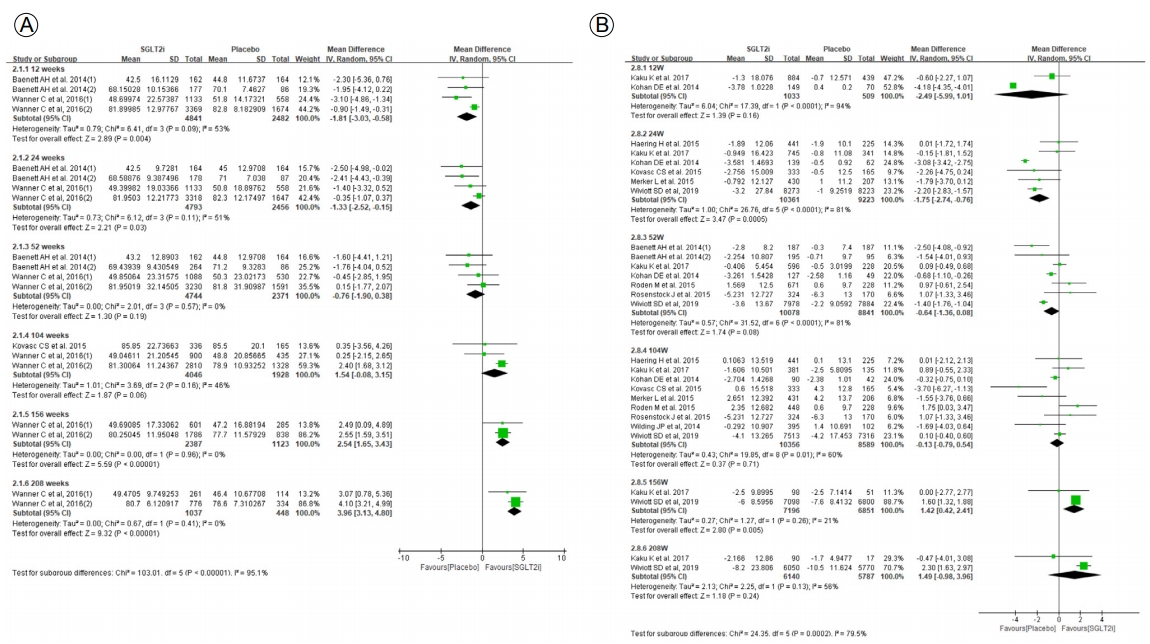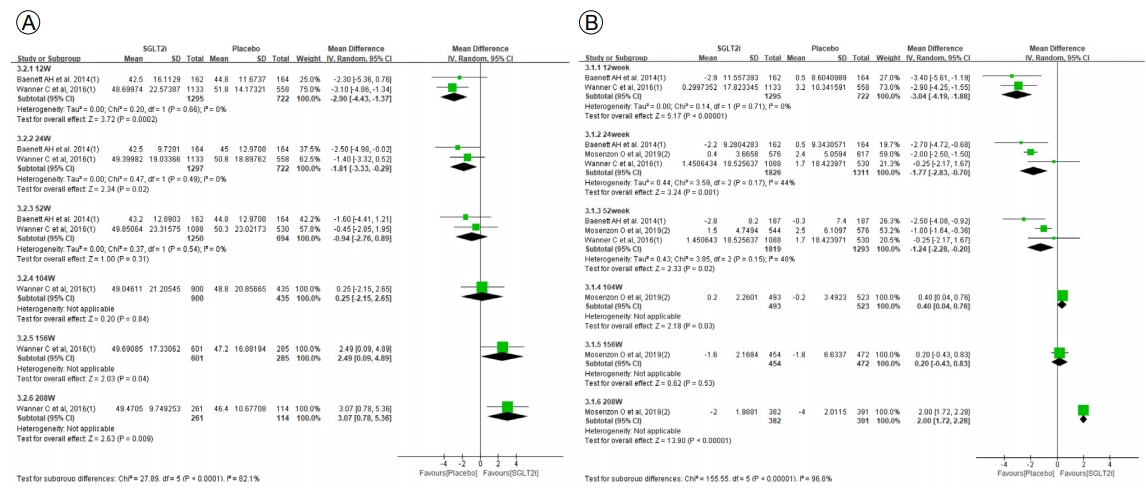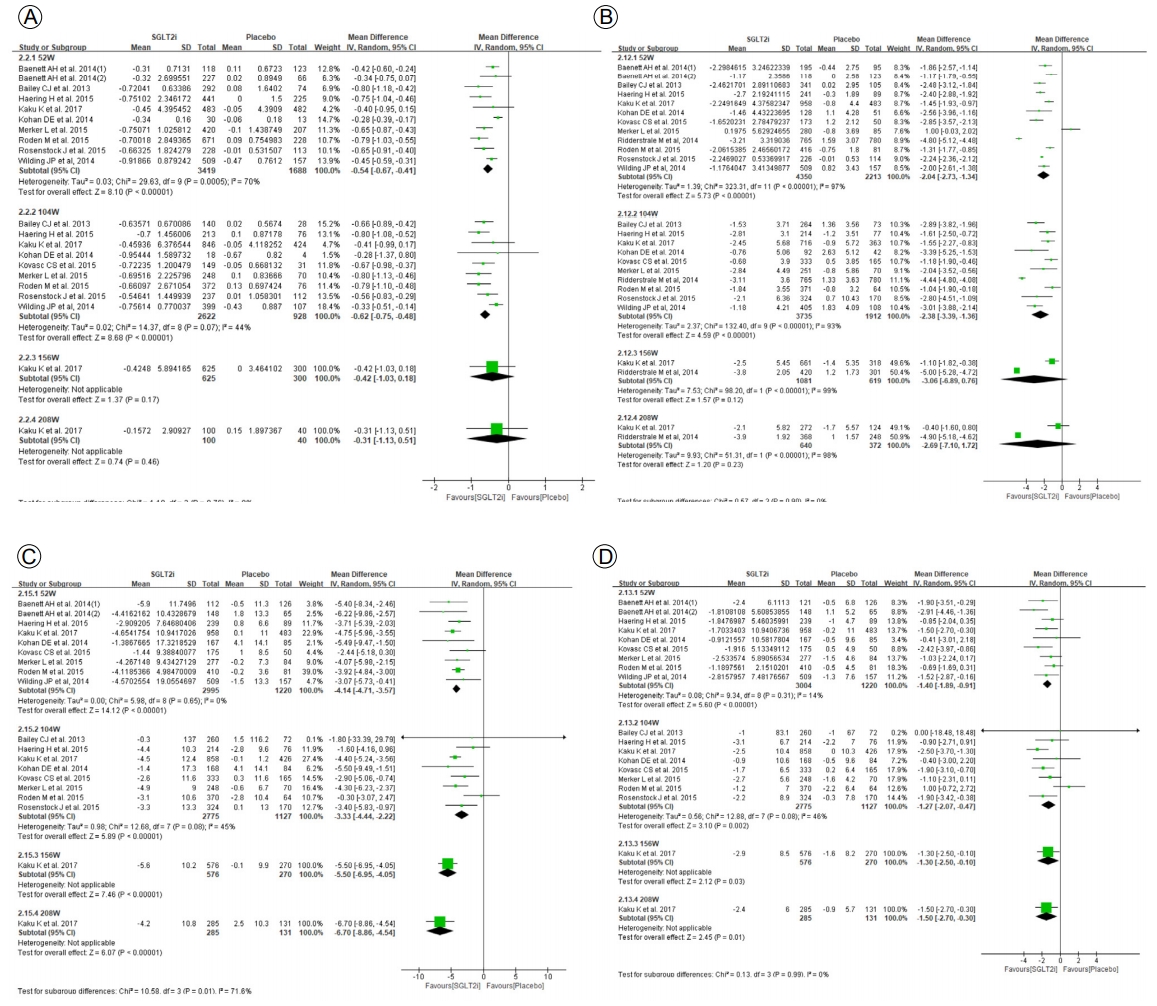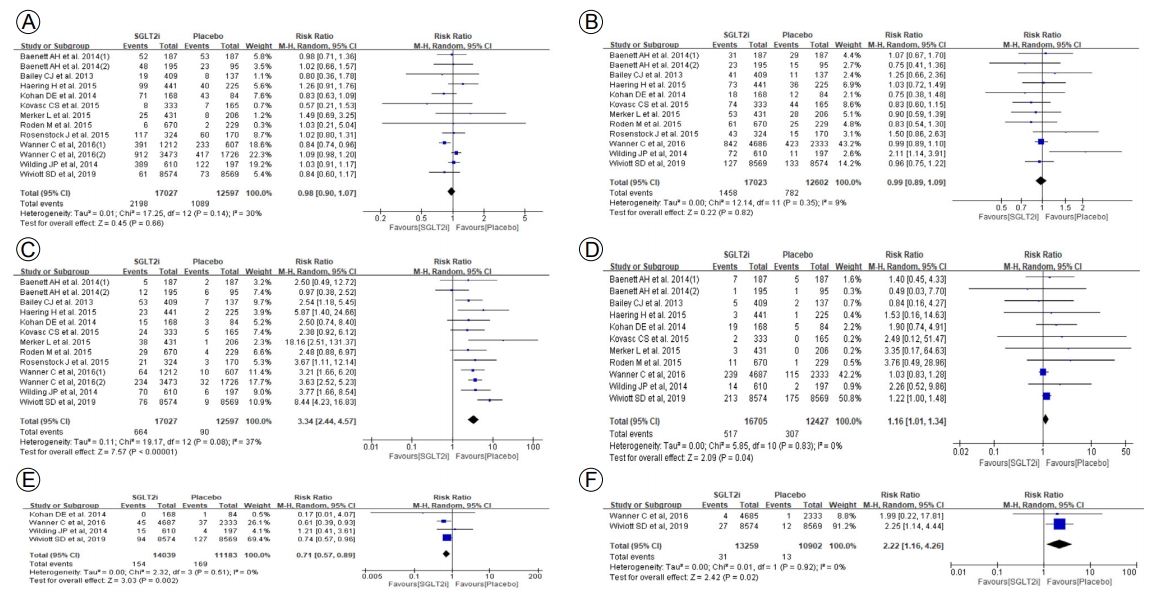 |
 |
| Korean J Med > Volume 95(4); 2020 > Article |
|
Abstract
Chronic kidney disease is developed commonly in type 2 diabetes mellitus (T2DM) and is the most common cause of end-stage renal disease and related cardiovascular complications. Meanwhile, despite the current standard of care including optimized glucose control and the use of single-agent blockade of the renin-angiotensin-aldosterone system (RAAS), patients with T2DM remain at increased risk for death and complications from cardiorenal causes. The recent studies using sodium-glucose cotransporter 2 (SGLT2) inhibitors have shown not only glucose lowering effect, but also a reduction in blood pressure, weight loss, and a lowering cardiovascular risk. Regarding renal outcomes, the use of SGLT2 inhibitor slows the progression of kidney disease compared to placebo when added to standard care. However, concern has been raised that currently available SGLT2 inhibitors in Korea may be also associated with improved renal outcomes with long-term treatment. As a result, we aimed to evaluate the effect of long-term SGLT2 inhibitor treatment on renal function in the patients with T2DM using meta-analysis. (Korean J Med 2020;95:236-243)
ļ¦īņä▒ ņŗĀņ¦łĒÖśņØĆ ļŗ╣ļć©ļ│æ ļśÉļŖö Ļ│ĀĒśłņĢĢĻ│╝ Ļ░ÖņØĆ ļ¦īņä▒ ņ¦łĒÖśņŚÉņä£ ņŻ╝ļĪ£ ĻĖ░ņØĖĒĢśļ®░, ĻĄŁļé┤ņŚÉņä£ļŖö ļ¦ÉĻĖ░ ņŗĀņ¦łĒÖśņ£╝ļĪ£ ņ¦äĒ¢ēĒĢśņŚ¼ ņŗĀļīĆņ▓┤ņÜöļ▓ĢņØä ļ░øļŖö ĒÖśņ×É ņżæ ļŗ╣ļć©ļ│æņŚÉ ņØśĒĢ£ ļ╣äņ£©ņØ┤ 2010ļģä ņØ┤Ēøä ĻĖēĻ▓®ĒĢśĻ▓ī ņ”ØĻ░ĆĒĢśņŚ¼ Ēśäņ×¼ ļŗ╣ļć©ļ│æņØ┤ Ļ░Ćņן ĒØöĒĢ£ ņøÉņØĖ ņ¦łĒÖśņ£╝ļĪ£ ņĢīļĀżņĀĖ ņ׳ļŗż[1]. ĒĢ£ĒÄĖ ļ¦īņä▒ ņŗĀņ¦łĒÖśņØĆ ļ¦ÉĻĖ░ ņŗĀļČĆņĀäņ£╝ļĪ£ņØś ņ¦äĒ¢ē, ņŗ¼ĒśłĻ┤Ć ņ¦łĒÖś ļ░£ņāØ ļ░Å ļåÆņØĆ ņé¼ļ¦ØļźĀĻ│╝ļÅä ņŚ░Ļ┤ĆļÉśņ¢┤ ņ׳ļŗż. Ēśäņ×¼Ļ╣īņ¦Ć ļ¦īņä▒ ņŗĀņ¦łĒÖśņØś ņĀüņĀłĒĢ£ ņ╣śļŻī ļ░Å Ļ┤Ćļ”¼ļĪ£ļŖö, ņĢīļČĆļ»╝ļć©ņØś ņ╣śļŻī(ņĢłņ¦ĆņśżĒģÉņŗĀņłśņÜ®ņ▓┤ņ░©ļŗ©ņĀ£ ļśÉļŖö ņĢłņ¦ĆņśżĒģÉņŗĀņĀäĒÖśĒÜ©ņåīņ¢ĄņĀ£ņĀ£), ņŗ¼ĒśłĻ┤Ć ņ£äĒŚśņØĖņ×ÉņØś ņĪ░ņĀł(ņØ┤ņāüņ¦Ćņ¦łĒśłņ”Ø, Ēśłļŗ╣ ļ░Å ĒśłņĢĢ Ļ┤Ćļ”¼)Ļ│╝ ĒĢ©Ļ╗ś ņ×Āņ×¼ņĀüņ£╝ļĪ£ ņŗĀļÅģņä▒ņØä ņ£Āļ░£ĒĢĀ ņłś ņ׳ļŖö ņĢĮņĀ£ņŚÉ ļīĆĒĢ£ ņŻ╝ņØś ļ░Å ņÜ®ļ¤ē ņĪ░ņĀł ļō▒ņØ┤ ņĀ£ņŗ£ļÉśĻ│Ā ņ׳ļŗż[2].
ņĄ£ĻĘ╝ sodium-glucose cotransporter 2 (SGLT2) ņ¢ĄņĀ£ņĀ£ņŚÉ Ļ┤ĆĒĢ£ ļīĆĻĘ£ļ¬© ņŗ¼ĒśłĻ┤Ć ņĢłņĀĢņä▒ ņŚ░ĻĄ¼ņŚÉņä£ Ēśłļŗ╣ Ļ░£ņäĀ ĒÜ©Ļ│╝ļŖö ļ¼╝ļĪĀ ņŗ¼ĒśłĻ┤Ć ņ¦łĒÖś ņé¼Ļ▒┤ ļ░Å ņé¼ļ¦ØļźĀņØä ļé«ņČśļŗżļŖö Ļ▓░Ļ│╝ļź╝ ļ│┤Ļ│ĀĒĢśņśĆļŗż[3-5]. ņØ┤ ņżæņŚÉņä£ canagliflozinĻ│╝ empagliflozinņØä ņØ┤ņÜ®ĒĢ£ ļ¼┤ņ×æņ£äĒÖö ļ╣äĻĄÉ ļīĆņĪ░ ņŚ░ĻĄ¼ņŚÉņä£ ņØ┤ņ░© Ļ▓░Ļ│╝ņ¦ĆĒæ£ļĪ£ņä£ ņŗĀĻĖ░ļŖź ļ│┤ĒśĖ ĒÜ©Ļ│╝ļź╝ ļ│┤ņŚ¼ņŻ╝ņŚłļŖöļŹ░, Ļ░üĻ░üņØś ņŗĀĻĖ░ļŖź ļ│ĄĒĢ® Ļ▓░Ļ│╝ņØś ĻĄ¼ņä▒ņŚÉ ņ׳ņ¢┤ņä£ļŖö ņ░©ņØ┤Ļ░Ć ņ׳ņŚłļŗż. EmpagliflozinņØä ņØ┤ņÜ®ĒĢ£ ņŚ░ĻĄ¼ļŖö ņŗĀĻĖ░ļŖź ņĢģĒÖöņØś ļ░£ņāØ ļśÉļŖö ņ¦äĒ¢ēņØä Ēśäņä▒ ņĢīļČĆļ»╝ļć©(ņåīļ│Ć ņĢīļČĆļ»╝-Ēü¼ļĀłņĢäĒŗ░ļŗī ļ╣äņ£© > 300 mg/dL), Ēśłņ▓Ł Ēü¼ļĀłņĢäĒŗ░ļŗī ņłśņ╣śņØś 2ļ░░ ņāüņŖ╣Ļ│╝ ĒĢ©Ļ╗ś ņśłņāü ņé¼ĻĄ¼ņ▓┤ ņŚ¼Ļ│╝ņ£©(estimated glomerular filtration rate, eGFR)ņØś Ļ░Éņåī(< 45 mL/min/1.73 m2), ņŗĀļīĆņ▓┤ņÜöļ▓ĢņØś ņŗ£ņ×æ ļśÉļŖö ņŗĀņ¦łĒÖśņ£╝ļĪ£ ņØĖĒĢ£ ņé¼ļ¦ØņØä Ļ▓░Ļ│╝ ņ¦ĆĒæ£ļĪ£ ņĀĢņØśĒĢśņśĆĻ│Ā[6], canagliflozinņØä ņØ┤ņÜ®ĒĢ£ ņŚ░ĻĄ¼ņŚÉņä£ļŖö ņśłņāü ņé¼ĻĄ¼ņ▓┤ ņŚ¼Ļ│╝ņ£©ņØś 40% Ļ░Éņåī, ņŗĀļīĆņ▓┤ņÜöļ▓ĢņØś ņŗ£Ē¢ē ļśÉļŖö ņŗĀņ¦łĒÖśņ£╝ļĪ£ ņØĖĒĢ£ ņé¼ļ¦Øņ£╝ļĪ£ Ļ▓░Ļ│╝ ņ¦ĆĒæ£ļź╝ ņĀĢņØśĒĢśņśĆļŗż[5]. DapagliflozinņØä ņØ┤ņÜ®ĒĢ£ ņŗ¼ĒśłĻ┤Ć ņĢłņĀĢņä▒ ņŚ░ĻĄ¼ņŚÉņä£ļŖö ņŗĀĻĖ░ļŖźņŚÉ ļīĆĒĢ£ Ļ▓░Ļ│╝ļŖö ļ│┤Ļ│ĀĒĢśņ¦Ć ņĢŖņĢśļŗż[4]. ĒĢ£ĒÄĖ Ļ░ü ņŚ░ĻĄ¼ņŚÉ ĒżĒĢ©ļÉ£ ĒÖśņ×ÉĻĄ░ņØś ņ×äņāü ņ¢æņāü ļ░Å ņŗĀĻĖ░ļŖź ņāüĒā£Ļ░Ć ļŗżļź┤Ļ│Ā Ļ░ü ņŚ░ĻĄ¼ ļ│äļĪ£ ņČöņĀü Ļ┤Ćņ░░ ĻĖ░Ļ░äņØ┤ ļŗ¼ļØ╝ņä£ SGLT2 ņ¢ĄņĀ£ņĀ£Ļ░Ć ņŗĀĻĖ░ļŖź ņ×Éņ▓┤ņŚÉ ņ¢┤ļ¢ĀĒĢ£ ņśüĒ¢źņØä ļ»Ėņ╣śļŖöņ¦ĆņŚÉ ļīĆĒĢ┤ņä£ļŖö ņĢäņ¦ü Ļ▓░ļĪĀņØä ļé┤ļ”┤ ņłś ņŚåļŗż. ļö░ļØ╝ņä£ ņÜ░ļ”¼ļŖö Ēśäņ×¼ ĻĄŁļé┤ņŚÉņä£ ņĀ£2ĒśĢ ļŗ╣ļć©ļ│æ ĒÖśņ×ÉņŚÉĻ▓ī ņ▓śļ░®ņØ┤ Ļ░ĆļŖźĒĢ£ SGLT2 ņ¢ĄņĀ£ņĀ£ ņżæ ņ£äņĢĮ ļīĆļ╣ä 52ņŻ╝ ņØ┤ņāü ņČöņĀü Ļ┤Ćņ░░ĒĢ£ ļ¼┤ņ×æņ£ä ļīĆņĪ░ĻĄ░ ņŚ░ĻĄ¼(review, case series, single arm study ņĀ£ņÖĖ)ļōżņŚÉņä£ ņןĻĖ░Ļ░ä SGLT2 ņ¢ĄņĀ£ņĀ£ ņ╣śļŻīĻ░Ć ņŗĀņןĻĖ░ļŖźņŚÉ ļ»Ėņ╣śļŖö ĒÜ©Ļ│╝ļź╝ ļ®öĒāĆļČäņäØņØä ĒåĄĒĢ┤ ņĢīņĢäļ│┤Ļ│Āņ×É ĒĢ£ļŗż. ļśÉĒĢ£ ņĀ£2ĒśĢ ļŗ╣ļć©ļ│æ ĒÖśņ×ÉņŚÉņä£ ņןĻĖ░Ļ░ä SGLT2 ņ¢ĄņĀ£ņĀ£ ņé¼ņÜ®ņŚÉ ļö░ļźĖ ņØ┤ļōØĻ│╝ ņ£äĒĢ┤ņØś ĻĘĀĒśĢņØä Ļ│ĀļĀżĒĢśņŚ¼ ĻČīĻ│ĀņĢłņŚÉ ļ░śņśüĒĢśĻ│Āņ×É ĒĢ£ļŗż.
ŌĆ£ņĀ£2ĒśĢ ļŗ╣ļć©ļ│æņŚÉņä£ ņןĻĖ░Ļ░äņØś SGLT2 ņ¢ĄņĀ£ņĀ£ ņ╣śļŻīļŖö ņŗĀņן ĻĖ░ļŖź Ļ░£ņäĀņŚÉ ļÅäņøĆņØ┤ ļÉśļŖöĻ░Ć?ŌĆØļź╝ ĒĢĄņŗ¼ ņ¦łļ¼Ėņ£╝ļĪ£ ĒĢśņŚ¼ ļ®öĒāĆļČäņäØņØä ņ£äĒĢ┤ ņĀäļ¼Ė ņé¼ņä£ņŚÉ ņØśĒĢ┤ ņ▓┤Ļ│äņĀüņØĖ ļ¼ĖĒŚī Ļ▓ĆņāēņØä ņŗ£Ē¢ēĒĢśņśĆļŗż. ļŹ░ņØ┤Ēä░ļ▓ĀņØ┤ņŖżļŖö PubMed, EMBASE, Cochrane libraryļź╝ ņØ┤ņÜ®ĒĢśņśĆĻ│Ā, 2015ļģä 1ņøö 1ņØ╝ļČĆĒä░ 2020ļģä 3ņøö 31ņØ╝Ļ╣īņ¦Ć ņśüļ¼Ėņ£╝ļĪ£ ļ░£Ēæ£ļÉ£ ļ¼ĖĒŚī ņżæ, ĻĄŁļé┤ņŚÉņä£ ņ▓śļ░® Ļ░ĆļŖźĒĢ£ SGLT2 ņ¢ĄņĀ£ņĀ£(dapagliflozin, empagliflozin, ipragliflozin, ertugliflozin)ļź╝ ņé¼ņÜ®ĒĢ£ ļ¼┤ņ×æņ£ä ļīĆņĪ░ ņ×äņāü ņŚ░ĻĄ¼ ņżæ ņĢĮņĀ£ ņ╣śļŻī ĻĖ░Ļ░äņØ┤ 52ņŻ╝ ņØ┤ņāüņØĖ ņŚ░ĻĄ¼ļ¦īņØä ĒżĒĢ©ĒĢśņśĆļŗż. ļ¼ĖĒŚīĻ│Āņ░░ Ļ▓░Ļ│╝, Ļ▓Ćņāē ņĪ░Ļ▒┤ņŚÉ ļö░ļØ╝ ņ£äņĢĮĻ│╝ ļ╣äĻĄÉļÉ£ ļ¼┤ņ×æņ£ä ļīĆņĪ░ ņ×äņāü ņŚ░ĻĄ¼ņØś Ļ▓░Ļ│╝Ļ░Ć ņ׳ļŖö dapagliflozin, empagliflozinļ¦ī ĒżĒĢ©ĒĢśņśĆĻ│Ā, ļ¼ĖĒŚī Ļ▓ĆņāēĻ│╝ ĒÅēĻ░Ćļź╝ ņ£äĒĢ£ population, intervention, comparator, outcomes (PICO)ļŖö Ēæ£ 1Ļ│╝ Ļ░Öļŗż.
ņØ┤ļōØņŚÉ Ļ┤ĆĒĢ£ 10Ļ░£ņØś ļ¼┤ņ×æņ£ä ļīĆņĪ░ ņ×äņāü ņŚ░ĻĄ¼ ņżæ 14Ļ░£ ļģ╝ļ¼Ė[4,6-18]ņØä ļČäņäØĒĢśĻ│Ā ļÅģļ”ĮļÉ£ 2ņØĖņØ┤ ĒÅēĻ░ĆĒĢśņśĆļŗż. Ļ░üĻ░üņØś ņŚ░ĻĄ¼ļōżņØĆ ļ╣äļÜżļ”╝ņŚÉ ļīĆĒĢ┤ņä£ļŖö ņżæĻ░ä Ēś╣ņØĆ ļåÆņØĆ ņ¦łļĪ£ ņל Ļ│äĒÜŹļÉśņŚłļŗżĻ│Ā ĒÅēĻ░ĆĒĢśņśĆņ£╝ļéś(Supplementary Fig. 1), ĒĢĄņŗ¼ ņ¦łļ¼ĖņØś ĻĘ╝Ļ▒░ņłśņżĆ(level of evidence) ĒÅēĻ░ĆņŚÉņä£ļŖö ļŗżņØīņØś ļæÉ Ļ░Ćņ¦Ć ņØ┤ņ£ĀļĪ£ ĒĢśĒ¢źņĪ░ņĀĢĒĢśņśĆļŗż.
1. ĻĘ╝Ļ▒░ņØś ņ¦üņĀæņä▒: ļīĆļČĆļČäņØś ņŚ░ĻĄ¼ņŚÉņä£ ņä£ņ¢æņØĖņØä ņŻ╝ ļīĆņāüņ×ÉļĪ£ ĒĢśņśĆĻ│Ā, ņŚ░ĻĄ¼ļ¦łļŗż ņĢäņŗ£ņĢäņØĖņØś ļ╣äņ£©ņØ┤ ļŗżņ¢æĒĢśņśĆņ£╝ļ®░, ņØ╝ļČĆņŚÉņä£ļŖö ņŗ¼ĒśłĻ┤Ć ņ¦łĒÖśņØä Ļ░Ćņ¦ä ļīĆņāüņ×Éļ¦ī ĒżĒĢ©ĒĢśļŖö ļō▒ ņŚ░ĻĄ¼ ļīĆņāü ņ¦æļŗ©ņØ┤ ļÅÖņØ╝ĒĢśņ¦Ć ņĢŖņĢśļŗż. ļśÉĒĢ£ ļīĆņāüņ×ÉņØś ĒÅēĻĘĀ ņ▓┤ņ¦łļ¤ēņ¦ĆņłśļŖö 30 kg/m2 ņĀĢļÅäļĪ£ ņÜ░ļ”¼ļéśļØ╝ ĒÖśņ×ÉļōżņØś ĒŖ╣ņä▒Ļ│╝ļŖö ņ░©ņØ┤Ļ░Ć ņ׳ņŚłļŗż. ņĢäņŗ£ņĢäņØĖņØś ļ╣äņ£©ņØ┤ 40% ņØ┤ņāüņØĖ 4Ļ░£ ņŚ░ĻĄ¼ļ¦īņØä ļČäņäØĒĢśļ®┤ SGLT2 ņ¢ĄņĀ£ņĀ£ņØś ņŗĀĻĖ░ļŖź ļ│┤ĒśĖ ĒÜ©Ļ│╝ļŖö ņżäņ¢┤ļōżņŚłļŗż.
2. ņŚ░ĻĄ¼ Ļ▓░Ļ│╝ņØś ņĀĢļ░Ćņä▒: ĒÅēĻ░ĆņŚÉ ĒżĒĢ©ļÉ£ ņŚ░ĻĄ¼ļōżņØĆ ļ¼┤ņ×æņ£ä ļ░░ņĀĢĻ│╝ ļłłĻ░Ćļ”╝(blinding)ņØ┤ ņל ņ£Āņ¦ĆļÉśņŚłņ£╝ļéś, ņČöņĀü Ļ┤Ćņ░░ ĻĖ░Ļ░ä ļÅÖņĢł ĒāłļØĮņØ┤ ļ¦ÄņĢśļŗż. ņØ╝ļČĆ ņŚ░ĻĄ¼ņŚÉņä£ļŖö ļō▒ļĪØļÉ£ ĒÖśņ×ÉņØś 20% ņĀĢļÅäļ¦ī ņóģļŻī ļĢīĻ╣īņ¦Ć ņČöņĀüļÉśņŚłĻ│Ā, ņ¢┤ļ¢ż ļīĆņāüņ×ÉĻ░Ć ĒāłļØĮĒĢśņśĆļŖöņ¦Ć ĻĘĖļ”¼Ļ│Ā ĒāłļØĮĒĢ£ ļīĆņāüņ×ÉļōżĻ│╝ ĻĘĖļĀćņ¦Ć ņĢŖņØĆ ļīĆņāüņ×Éļōż Ļ░äņŚÉ ņ░©ņØ┤Ļ░Ć ņ׳ļŖöņ¦Ć ņĢī ņłś ņŚåņŚłļŗż. ņ”ē, ļīĆņāüņ×ÉļōżņØś ĒāłļØĮļźĀņØ┤ ļåÆņĢä ņןĻĖ░Ļ░ä ņČöņĀü Ļ┤Ćņ░░ļÉ£ ļīĆņāüņ×ÉļōżņØś Ļ▓░Ļ│╝Ļ░Ć ņĀäņ▓┤ ļīĆņāüņ×ÉļōżņØś Ļ▓░Ļ│╝ļź╝ ļÆĘļ░øņ╣©ĒĢśļŖö ņČ®ļČäĒĢ£ ņĀĢļ│┤(ņé¼Ļ▒┤ņłś)ļØ╝Ļ│Ā ļ│┤ĻĖ░ ņ¢┤ļĀżņøĀļŗż. ļö░ļØ╝ņä£ ĻĘ╝Ļ▒░ņłśņżĆņØä ŌĆ£ļé«ņØī(low evidence)ŌĆØņ£╝ļĪ£ ĒÅēĻ░ĆĒĢśņśĆļŗż.
ņŗĀņןĻĖ░ļŖźņØś ņØ╝ņ░© Ļ▓░Ļ│╝ņ¦ĆĒæ£(primary outcome)ļĪ£ ņé¼ĻĄ¼ņ▓┤ ņŚ¼Ļ│╝ņ£©(mL/min/1.73 m2)ņØä ņäĀņĀĢĒĢśņśĆĻ│Ā, ņĄ£ļīĆ 208ņŻ╝Ļ╣īņ¦Ć ļ│┤Ļ│ĀļÉ£ Ļ▓░Ļ│╝ļōżņØä ļīĆņāüņ£╝ļĪ£ ļ®öĒāĆļČäņäØņØä ņŗżņŗ£ĒĢśņśĆļŗż. 12ņŻ╝ņÖĆ 24ņŻ╝ņŚÉņä£ļŖö ņżæņ×¼ĻĄ░ņØś ņé¼ĻĄ¼ņ▓┤ ņŚ¼Ļ│╝ņ£©ņØ┤ ļīĆņĪ░ĻĄ░ņŚÉ ļ╣äĒĢ┤ ļé«ņĢśĻ│Ā(12ņŻ╝: -1.81, 95% CI -3.03 to -0.58, 24ņŻ╝: -1.33, 95% CI -2.52 to -0.15), 52ņŻ╝ņÖĆ 104ņŻ╝ņŚÉņä£ļŖö ļīĆņĪ░ĻĄ░Ļ│╝ ņ░©ņØ┤Ļ░Ć ņŚåņŚłĻ│Ā(52ņŻ╝: -0.76, 95% CI -1.90 to 0.38, 104ņŻ╝: 1.54, 95% CI -0.08 to 3.15, 156ņŻ╝ņÖĆ 208ņŻ╝ņŚÉņä£ļŖö ļīĆņĪ░ĻĄ░ļ│┤ļŗż ņ£ĀņØśĒĢśĻ▓ī ļåÆņĢśļŗż(156ņŻ╝: 2.54, 95% CI 1.65 to 3.43, 208ņŻ╝: 3.96, 95% CI 3.13 to 4.80) (Fig. 1A). ņé¼ĻĄ¼ņ▓┤ ņŚ¼Ļ│╝ņ£©ņØś ļ│ĆĒÖö(mean change of eGFR, mL/min/1.73 m2) ļŖö 156ņŻ╝ņŚÉņä£ ņżæņ×¼ĻĄ░ņØ┤ ļīĆņĪ░ĻĄ░ļ│┤ļŗż ņ£ĀņØśĒĢśĻ▓ī ļåÆņĢśļŗż(156ņŻ╝: 1.42, 95% CI 0.42 to 2.41) (Fig. 1B).
ļČäņäØ ļīĆņāüņ×É ņżæ ļ¦īņä▒ ņŗĀņ¦łĒÖś 3ĻĖ░(ņé¼ĻĄ¼ņ▓┤ ņŚ¼Ļ│╝ņ£© 30-59 mL/min/1.73 m2) ļīĆņāüņ×Éļ¦īņØä ļö░ļĪ£ ļČäņäØĒĢśņśĆņØä ļĢī, 12ņŻ╝ņÖĆ 24ņŻ╝ņŚÉņä£ļŖö ņżæņ×¼ĻĄ░ņØś ņé¼ĻĄ¼ņ▓┤ ņŚ¼Ļ│╝ņ£©ņØ┤ ļīĆņĪ░ĻĄ░ņŚÉ ļ╣äĒĢ┤ ļé«ņĢśĻ│Ā(12ņŻ╝: -2.90, 95% CI -4.43 to -1.37, 24ņŻ╝: -1.81, 95% CI -3.33 to -0.29) 156ņŻ╝ņÖĆ 208ņŻ╝ņŚÉņä£ļŖö ņżæņ×¼ĻĄ░ņØś ņé¼ĻĄ¼ņ▓┤ ņŚ¼Ļ│╝ņ£©ņØ┤ ļīĆņĪ░ĻĄ░ņŚÉ ļ╣äĒĢ┤ ļåÆņØĆ Ļ▓ĮĒ¢źņØä ļ│┤ņśĆļŗż(156ņŻ╝: 2.49, 95% CI 0.09 to 4.89, 208ņŻ╝: 3.07, 95% CI 0.78 to 5.36) (Fig. 2A). ņé¼ĻĄ¼ņ▓┤ ņŚ¼Ļ│╝ņ£© ļ│ĆĒÖö(mean change of eGFR, mL/min/1.73 m2) 208ņŻ╝ņ¦Ė ļīĆņĪ░ĻĄ░ļ│┤ļŗż ņżæņ×¼ĻĄ░ņŚÉņä£ ņ£ĀņØśļ»ĖĒĢ£ ĒÜ©Ļ│╝ ņČöņĀĢņ╣śļź╝ ļ│┤ņśĆļŗż(208ņŻ╝: 2.00, 95% CI 1.72 to 2.28) (Fig. 2B).
ņĀäņ▓┤ ļīĆņāüņ×ÉņŚÉņä£ ļŗ╣ĒÖöĒśłņāēņåī, ņ▓┤ņżæ, ĒśłņĢĢ ļ│ĆĒÖöļź╝ ļ╣äĻĄÉĒĢśņśĆņØä ļĢī, 104ņŻ╝ņ¦Ė ņżæņ×¼ĻĄ░ņŚÉņä£ ļŗ╣ĒÖöĒśłņāēņåī ļ│ĆĒÖöļŖö -0.62% (95% CI -0.75 to 0.48), ņ▓┤ņżæ ļ│ĆĒÖöļŖö -2.38 kg (95% CI -3.39 to -1.36), ņłśņČĢĻĖ░ ĒśłņĢĢ ļ│ĆĒÖöļŖö -3.33 mmHg (95% CI -4.44 to -2.22), ņØ┤ņÖäĻĖ░ ĒśłņĢĢ ļ│ĆĒÖöļŖö -1.27 mmHg (95% CI -2.07 to -0.47)ļĪ£ Ēśłļŗ╣, ņ▓┤ņżæ, ĒśłņĢĢņØĆ ļīĆņĪ░ĻĄ░ ļīĆļ╣ä ņżæņ×¼ĻĄ░ņŚÉņä£ ņ£ĀņØśļ»ĖĒĢ£ Ļ░Éņåīļź╝ ļ│┤ņśĆļŗż(Fig. 3). ņØ┤ņāüņŚÉņä£ ņĀ£2ĒśĢ ļŗ╣ļć©ļ│æ ĒÖśņ×ÉņŚÉņä£ ņןĻĖ░Ļ░ä SGLT2 ņ¢ĄņĀ£ņĀ£ ņ╣śļŻīļŖö ņé¼ĻĄ¼ņ▓┤ ņŚ¼Ļ│╝ņ£© Ļ░Éņåīļź╝ ņ¢ĄņĀ£ĒĢśļŖö ĒÜ©Ļ│╝Ļ░Ć ņ׳ņØä Ļ▓āņ£╝ļĪ£ ĻĖ░ļīĆļÉ£ļŗż.
ļīĆņĪ░ĻĄ░ļ│┤ļŗż ņżæņ×¼ĻĄ░ņŚÉņä£ ņ┤łļ░śĻĖ░ ņé¼ĻĄ¼ņ▓┤ ņŚ¼Ļ│╝ņ£© Ļ░ÉņåīĻ░Ć ņ׳ņŚłņ£╝ļ®░(Fig. 1), ĒŖ╣Ē׳ ļ¦īņä▒ ņŗĀņ¦łĒÖś 3ĻĖ░ ĒÖśņ×ÉņŚÉņä£ļŖö SGLT2 ņ¢ĄņĀ£ņĀ£ ņé¼ņÜ® ņ┤łĻĖ░ņŚÉ ņé¼ĻĄ¼ņ▓┤ ņŚ¼Ļ│╝ņ£© Ļ░ÉņåīĻ░Ć ļŹö Ēü¼Ļ▓ī ļéśĒāĆļé¼ļŗż(Fig. 3). ĒĢśņ¦Ćļ¦ī 2ļģä ņØ┤ņāü ņČöņĀü Ļ┤Ćņ░░ ĻĖ░Ļ░ä ļÅÖņĢł ĒāłļØĮļÉ£ ĒÖśņ×ÉĻ░Ć ļ¦ÄņĢä ņ┤łļ░śņŚÉ ņé¼ĻĄ¼ņ▓┤ ņŚ¼Ļ│╝ņ£© Ļ░Éņåīļź╝ ļ│┤ņśĆļŹś ļīĆņāüņ×ÉļōżņŚÉņä£ ņØ┤Ēøä ņé¼ĻĄ¼ņ▓┤ ņŚ¼Ļ│╝ņ£©ņØ┤ ĒÜīļ│ĄļÉśņŚłļŖöņ¦Ć ņŚ¼ļČĆņŚÉ ļīĆĒĢ┤ņä£ļŖö ņĢī ņłś ņŚåņŚłĻĖ░ ļĢīļ¼ĖņŚÉ SGLT2 ņ¢ĄņĀ£ņĀ£ ņé¼ņÜ® ņŗ£ ņ┤łĻĖ░ņŚÉ ņŗĀņןĻĖ░ļŖźņØä ļ¬©ļŗłĒä░ļ¦üĒĢśĻ│Ā ņØ┤ĒøäņŚÉļÅä ņĀĢĻĖ░ņĀüņØ┤Ļ│Ā ņ¦ĆņåŹņĀüņØĖ ļ¬©ļŗłĒä░ļ¦üņØ┤ ĒĢäņÜöĒĢśļŗż.
208ņŻ╝ Ļ┤Ćņ░░ ĻĖ░Ļ░ä ļÅÖņĢł ņżæņ×¼ĻĄ░ņŚÉņä£ ņĀĆĒśłļŗ╣ ļ░£ņāØ(RR 0.98, 95% CI 0.90 to 1.07), ņÜöļĪ£Ļ░ÉņŚ╝(RR 0.99, 95% CI 0.89 to 1.09)ņØś ņ£äĒŚśņØĆ ņ”ØĻ░ĆĒĢśņ¦Ć ņĢŖņĢśņ£╝ļéś, ņāØņŗØĻĖ░Ļ│ä Ļ░ÉņŚ╝(RR 3.34, 95% CI 2.44 to 4.57)Ļ│╝ ņłśļČä ļČĆņĪ▒(RR 1.16, 95% CI 1.01 to 1.34)ņØĆ ņØśļ»Ėņ׳Ļ▓ī ņ”ØĻ░ĆĒĢśņśĆļŗż. ļ░śļ®┤ ĻĖēņä▒ ņŗĀļČĆņĀä(RR 0.71, 95% CI 0.57 to 0.89), ļŗ╣ļć©ļ│æņä▒ņ╝ĆĒåżņé░ņ”Ø(RR 2.22, 95% CI 1.16 to 4.26)ņØś ļ░£ņāØņØĆ ĒåĄĻ│äņĀüņ£╝ļĪ£ļŖö ņ£ĀņØśļ»ĖĒĢśņśĆņ£╝ļéś ļ░£ņāØĻ▒┤ņłśĻ░Ć ļäłļ¼┤ ņĀüņ¢┤ņä£ ņ×äņāüņĀü ņ£ĀņØśņä▒ņØĆ ņŚåļŖö Ļ▓āņ£╝ļĪ£ ļ│┤ņØĖļŗż(Fig. 4).
ņĀ£2ĒśĢ ļŗ╣ļć©ļ│æ ĒÖśņ×ÉņŚÉņä£ 2ļģä Ēś╣ņØĆ ĻĘĖ ņØ┤ņāü ņןĻĖ░Ļ░ä SGLT2 ņ¢ĄņĀ£ņĀ£ ņ╣śļŻī ņŗ£ ņ£äņĢĮ ļīĆļ╣ä ņé¼ĻĄ¼ņ▓┤ ņŚ¼Ļ│╝ņ£© Ļ░Éņåīļź╝ ņ¢ĄņĀ£ĒĢśļŖö ĒÜ©Ļ│╝Ļ░Ć ņ׳ņŚłļŗż(Figs. 1 and 2). ļśÉĒĢ£ ļŗ╣ĒÖöĒśłņāēņåīņØś Ļ░ÉņåīņÖĆ ĒĢ©Ļ╗ś ņ▓┤ņżæ, ņłśņČĢĻĖ░ ļ░Å ņØ┤ņÖäĻĖ░ ĒśłņĢĢņØś Ļ░ÉņåīļĪ£ ņØĖĒĢ£ ņČöĻ░Ć ņØ┤ļōØņØ┤ Ļ┤Ćņ░░ļÉśņŚłļŗż(Fig. 3). SGLT2 ņ¢ĄņĀ£ņĀ£ ņ╣śļŻī ņŗ£ ļ░£ņāØĒĢĀ ņłś ņ׳ļŖö ņ£äĒĢ┤ļĪ£ļŖö ņāØņŗØĻĖ░Ļ│ä Ļ░ÉņŚ╝, Ēāłņłś ļō▒ņØ┤ ņ׳ņŚłņ£╝ļéś ņāØņŗØĻĖ░Ļ│ä Ļ░ÉņŚ╝ņØ┤ļéś ĒāłņłśļŖö ļ╣äĻĄÉņĀü Ļ░äļŗ©ĒĢ£ ņśłļ░®ņĀü ņĪ░ņ╣śņÖĆ ņ╣śļŻīļĪ£ ņēĮĻ▓ī Ļ░£ņäĀļÉśļ»ĆļĪ£ ņŗ¼Ļ░üĒĢ£ ņ£äĒĢ┤ļŖö ņĢäļŗī Ļ▓āņ£╝ļĪ£ ĒīÉļŗ©ļÉ£ļŗż(Fig. 4). ļö░ļØ╝ņä£ ņØ┤ļź╝ ņóģĒĢ®ĒĢ┤ ļ│╝ ļĢī ņØ┤ļōØņØ┤ ņ£äĒĢ┤ļź╝ ņĢ×ņäĀļŗżĻ│Ā ļ│╝ ņłś ņ׳ļŗż.
ĻĘĖļ¤¼ļéś 2ļģä ņØ┤ņāü ņé¼ĻĄ¼ņ▓┤ ņŚ¼Ļ│╝ņ£©ņØä ņןĻĖ░ ņČöņĀü Ļ┤Ćņ░░ĒĢ£ ņŚ░ĻĄ¼Ļ░Ć ņĀüĻ│Ā ĻĘĖļéśļ¦ł ņןĻĖ░Ļ░ä ņŚ░ĻĄ¼ļōżņŚÉņä£ļŖö ĒāłļØĮļźĀņØ┤ ļåÆņĢśļŗż. ĒĢ£ĒÄĖ ļ¦īņä▒ ņŗĀņ¦łĒÖś 3ĻĖ░ņŚÉņä£ļÅä ņØśļ»Ė ņ׳ļŖö ĒÜ©Ļ│╝ņČöņĀĢņ╣śļź╝ ļ│┤ņśĆņ£╝ļéś ņØ┤ ļČäņäØņŚÉ ĒżĒĢ©ļÉ£ ņŚ░ĻĄ¼Ļ░Ć ļŗ© 1Ļ░£ļ┐ÉņØ┤ņ¢┤ņä£(Fig. 2) ņżæļō▒ļÅäņØś ņŗĀĻĖ░ļŖź ņĀĆĒĢśļź╝ ļÅÖļ░śĒĢ£ ĒÖśņ×ÉņŚÉņä£ SGLT2 ņ¢ĄņĀ£ņĀ£ņØś ņŗĀņןĻĖ░ļŖźņŚÉ ļīĆĒĢ£ ĒÜ©Ļ│╝ļŖö ņČöĻ░ĆņĀüņØĖ ņŚ░ĻĄ¼ļź╝ ĒåĄĒĢ┤ ĒÖĢņØĖņØ┤ ĒĢäņÜöĒĢśļŗż. ļīĆņĪ░ĻĄ░ņŚÉ ļ╣äĒĢ┤ ņżæņ×¼ĻĄ░ņŚÉņä£ ņ┤łļ░śņŚÉ ņé¼ĻĄ¼ņ▓┤ ņŚ¼Ļ│╝ņ£©ņØ┤ Ļ░ÉņåīĒĢśņśĆļŖöļŹ░(Fig. 1), ļ¦īņä▒ ņŗĀņ¦łĒÖś 3ĻĖ░ ļīĆņāüņ×ÉļōżņØĆ ĻĘĖ Ļ░ÉņåīĻ░Ć ļŹö ņ╗Ėļŗż(Fig. 2). ļö░ļØ╝ņä£ SGLT2 ņ¢ĄņĀ£ņĀ£ ņ╣śļŻī ņŗ£ ņ┤łļ░śĻĖ░ ņé¼ĻĄ¼ņ▓┤ ņŚ¼Ļ│╝ņ£© Ļ░ÉņåīņŚÉ ļīĆĒĢ£ ņ£äĒĢ┤Ļ░Ć ņĪ┤ņ×¼ĒĢśļ»ĆļĪ£ SGLT2 ņ¢ĄņĀ£ņĀ£ ņé¼ņÜ® ņŗ£ ņŗĀņןĻĖ░ļŖźņŚÉ ļīĆĒĢ£ ņĀĢĻĖ░ņĀüņØ┤Ļ│Ā ņ¦ĆņåŹņĀüņØ┤ ļ¬©ļŗłĒä░ļ¦üņØ┤ ļ¦żņÜ░ ņżæņÜöĒĢśļŗż.
ĒĢ£ĒÄĖ, ņĢäņŗ£ņĢäņØĖņØ┤ ļŗżņłś ĒżĒĢ©ļÉ£ ņŚ░ĻĄ¼ Ļ▓░Ļ│╝ļŖö ņĀäņ▓┤ ļīĆņāüņ×ÉņØś ņŚ░ĻĄ¼ Ļ▓░Ļ│╝ņÖĆ ļŗ¼ļ×ÉļŖöļŹ░ ņĀäņ▓┤ ļīĆņāüņ×É ņŚ░ĻĄ¼ņŚÉņä£ļŖö ņ┤łļ░śĻĖ░ ņé¼ĻĄ¼ņ▓┤ ņŚ¼Ļ│╝ņ£©ņØ┤ Ļ░ÉņåīļÉśļŗżĻ░Ć ņŗ£Ļ░äņØ┤ ņ¦Ćļéśļ®┤ņä£ ĒÜīļ│ĄļÉśņ¢┤ 2ļģä ņ┤łĻ│╝ ņŗ£ Ļ░£ņäĀļÉśļŖö Ļ▓ĮĒ¢źņØä ļ│┤ņśĆļŖöļŹ░, ņĢäņŗ£ņĢäņØĖņØ┤ ļŗżņłś ĒżĒĢ©ļÉ£ ņŚ░ĻĄ¼ņŚÉņä£ļŖö ļīĆņĪ░ĻĄ░Ļ│╝ ņżæņ×¼ĻĄ░ Ļ░ä ņ┤łļ░śĻĖ░ ņé¼ĻĄ¼ņ▓┤ ņŚ¼Ļ│╝ņ£© Ļ░ÉņåīņØś ņ░©ņØ┤Ļ░Ć ņŚåņŚłĻ│Ā, 208ņŻ╝Ļ╣īņ¦Ć ņןĻĖ░Ļ░ä ņČöņĀü Ļ┤Ćņ░░ ĻĖ░Ļ░ä ļÅÖņĢłņŚÉļÅä ņ£ĀņØśļ»ĖĒĢ£ ņ░©ņØ┤Ļ░Ć ņŚåņŚłļŗż(ņé¼ĻĄ¼ņ▓┤ ņŚ¼Ļ│╝ņ£© ļ│ĆĒÖö, -0.47 mL/min/1.73 m2 [95% CI, -4.01 to 3.08]) (Supplementary Fig. 2). ļö░ļØ╝ņä£ ņĢäņŗ£ņĢäņØĖņŚÉņä£ļÅä ņןĻĖ░Ļ░äņØś SGLT2 ņ¢ĄņĀ£ņĀ£ ņ╣śļŻīĻ░Ć ņé¼ĻĄ¼ņ▓┤ ņŚ¼Ļ│╝ņ£© Ļ░Éņåīļź╝ ņ¢ĄņĀ£ĒĢśļŖö ĒÜ©Ļ│╝Ļ░Ć ņ׳ņØäņ¦ĆņŚÉ ļīĆĒĢ┤ņä£ļŖö ņĢäņ¦ü ļČłļČäļ¬ģĒĢśļŗż. ĻĘĖļ¤¼ļ»ĆļĪ£ Ē¢źĒøä ņĢäņŗ£ņĢäņØĖ, ĒŖ╣Ē׳ ĒĢ£ĻĄŁņØĖņØä ļīĆņāüņ£╝ļĪ£ ĒĢ£ ņČöĻ░ĆņĀüņØĖ ņŚ░ĻĄ¼ Ļ▓░Ļ│╝Ļ░Ć ĒĢäņÜöĒĢśļŗż.
ņØ┤ļōØĻ│╝ ņ£äĒĢ┤ļź╝ ņóģĒĢ®ĒĢśņśĆņØä ļĢī, SGLT2 ņ¢ĄņĀ£ņĀ£ļŖö ņ£äņĢĮņŚÉ ļ╣äĒĢ┤ ņé¼ĻĄ¼ņ▓┤ ņŚ¼Ļ│╝ņ£© Ļ░Éņåīļź╝ ņ¢ĄņĀ£ĒĢśļŖö ņØ┤ļōØņØ┤ ņ׳ņØä ņłś ņ׳ņ£╝ļéś ĻĘĖ ņØ┤ļōØņØ┤ ļÉśļŖö ļīĆņāüĻĄ░ņØ┤ ļ¬ģĒÖĢĒĢśņ¦Ć ņĢŖņ£╝ļ®░, ņŗ¼Ļ░üĒĢ£ ņ£äĒĢ┤ļŖö ņŚåņ£╝ļéś ņ┤łļ░śĻĖ░ ņé¼ĻĄ¼ņ▓┤ ņŚ¼Ļ│╝ņ£© ņĀĆĒĢśĻ░Ć ņ׳ņØä ņłś ņ׳ņ£╝ļ»ĆļĪ£ ņĢĮņĀ£ ņé¼ņÜ® ņŗ£ņŚÉ ņŗĀņןĻĖ░ļŖźņŚÉ ļīĆĒĢ£ ļ¬©ļŗłĒä░ļ¦üĻ│╝ ņŻ╝ņØśĻ░Ć ĒĢäņÜöĒĢśļŗż. ļśÉĒĢ£ ņØ┤ļ¤¼ĒĢ£ ņØ┤ļōØĻ│╝ ņ£äĒĢ┤ņØś ĻĘĀĒśĢņŚÉ ņ׳ņ¢┤ņä£ ļČłĒÖĢņŗżņä▒ņØ┤ ņĪ┤ņ×¼ĒĢśļ»ĆļĪ£ ņé¼ĻĄ¼ņ▓┤ ņŚ¼Ļ│╝ņ£© Ļ░Éņåī ņ¢ĄņĀ£ļź╝ ļ¬®ņĀüņ£╝ļĪ£ ļ¬©ļōĀ ņĀ£2ĒśĢ ļŗ╣ļć©ļ│æ ĒÖśņ×ÉņŚÉĻ▓ī SGLT2 ņ¢ĄņĀ£ņĀ£ ņé¼ņÜ®ņØä ĻČīĻ│ĀĒĢĀ ņłśļŖö ņŚåļŗż. ļö░ļØ╝ņä£ ĻČīĻ│Ā Ļ░ĢļÅäļŖö ŌĆ£weak recommendationŌĆØņ£╝ļĪ£ Ļ▓░ņĀĢĒĢśņśĆļŗż. ņØ┤ņŚÉ ņĄ£ņóģ ĻČīĻ│ĀņĢłņØĆ ļŗżņØīĻ│╝ Ļ░ÖņØ┤ Ļ▓░ņĀĢĒĢśņśĆļŗż.
ņĀ£2ĒśĢ ļŗ╣ļć©ļ│æņŚÉņä£ ņןĻĖ░Ļ░äņØś SGLT-2 ņ¢ĄņĀ£ņĀ£ ņ╣śļŻīļŖö ņØ╝ļČĆ ļīĆņāüņ×ÉņŚÉņä£ ņé¼ĻĄ¼ņ▓┤ ņŚ¼Ļ│╝ņ£© Ļ░Éņåīļź╝ ņ¢ĄņĀ£ĒĢśļŖö ĒÜ©Ļ│╝Ļ░Ć ņ׳ņ£╝ļ»ĆļĪ£, ņé¼ĻĄ¼ņ▓┤ ņŚ¼Ļ│╝ņ£©ņØä ņ¦ĆņåŹņĀüņ£╝ļĪ£ ņČöņĀü Ļ┤Ćņ░░ĒĢśļ®┤ņä£ SGLT-2 ņ¢ĄņĀ£ņĀ£ļź╝ ņé¼ņÜ®ĒĢĀ Ļ▓āņØä ĻČīĻ│ĀĒĢ£ļŗż(weak recommendation, low evidence).
ņĀ£2ĒśĢ ļŗ╣ļć©ļ│æ ĒÖśņ×ÉņŚÉĻ▓ī ņČöĻ░Ć ļ│æĒĢ®ņÜöļ▓Ģņ£╝ļĪ£ ņäĀĒāØĒĢĀ ņłś ņ׳ļŖö Ēśłļŗ╣Ļ░ĢĒĢśņĀ£ļōżņØĆ SGLT2 ņ¢ĄņĀ£ņĀ£ ņÖĖņŚÉļÅä Ļ▓ĮĻĄ¼ Ēśłļŗ╣Ļ░ĢĒĢśņĀ£ņÖĆ ņŻ╝ņé¼ņĀ£Ļ░Ć ņ׳ņ£╝ļéś, Ēśäņ×¼ļĪ£ņä£ļŖö ņןĻĖ░Ļ░ä ņŗĀņןĻĖ░ļŖź Ļ░£ņäĀĒÜ©Ļ│╝ļź╝ ņ×ģņ”ØĒĢ£ ĻĘ╝Ļ▒░Ļ░Ć ļČĆņĪ▒ĒĢśļ®░ ņé¼ĻĄ¼ņ▓┤ ņŚ¼Ļ│╝ņ£© ļ│ĆĒÖöļź╝ ļ│┤ĻĖ░ ņ£äĒĢ┤ņä£ļŖö ņĄ£ņåīĒĢ£ 1ļģä ņØ┤ņāüņØś ņןĻĖ░ņĀüņØĖ ņ╣śļŻī, ļÅÖļ░ś ņ£äĒŚśņØĖņ×ÉņØś ĻĄÉņĀĢ(Ļ│ĀĒśłņĢĢ, ņØ┤ņāüņ¦Ćņ¦łĒśłņ”Ø, ļ╣äļ¦ī ļō▒), ĻĖ░ĒāĆ ņŗĀņןĻĖ░ļŖź Ļ░£ņäĀņØ┤ ņ”Øļ¬ģļÉ£ ņĢĮņĀ£(ņĢłņ¦ĆņśżĒģÉņŗĀņĀäĒÖśņ¢ĄņĀ£ņĀ£, ņĢłņ¦ĆņśżĒģÉņŗĀņłśņÜ®ņ▓┤ņ░©ļŗ©ņĀ£ ļō▒)ņØś ņÜ░ņäĀņł£ņ£ä ļō▒ņØä ņČ®ļČäĒ׳ Ļ│ĀļĀżĒĢśņŚ¼ Ļ▓░ņĀĢĒĢ┤ņĢ╝ ĒĢ£ļŗż. SGLT2 ņ¢ĄņĀ£ņĀ£ Ēł¼ņŚ¼ Ēøä ĒÖśņ×ÉņØś ņŻ╝Ļ┤ĆņĀü ļČłĒÄĖĻ░É(ĻĖēĻ▓®ĒĢ£ ņ▓┤ņżæ Ļ░Éņåīļéś ļ╣łļć© ļō▒), ņÜöļĪ£Ļ░ÉņŚ╝, ļ╣äņÜ®, ņ┤łĻĖ░ ņŗĀņןĻĖ░ļŖź Ļ░ÉņåīņŚÉ ļīĆĒĢ┤ ņØśņé¼ņØś ļČĆļŗ┤Ļ░ÉņŚÉ ļīĆĒĢ£ Ļ│ĀļĀżĻ░Ć ĒĢäņÜöĒĢśļ®░, Ļ░ÉņŚ╝ņØ┤ļéś ĒāłņłśņŚÉ ļīĆĒĢ£ ļ¼ĖņĀ£ļŖö ĒÖśņ×ÉņŚÉĻ▓ī ļ»Ėļ”¼ ļ░£ņāØ Ļ░ĆļŖźņä▒ņØä ņČ®ļČäĒ׳ Ļ│Āņ¦ĆĒĢśĻ│Ā ņĪ░ĻĖ░ ļ░£Ļ▓¼ ļ░Å ņĀüņĀłĒĢ£ ņĪ░ņ╣śļĪ£ ĒĢ┤Ļ▓░ĒĢĀ ņłś ņ׳ļÅäļĪØ ĒĢ┤ņĢ╝ ĒĢ£ļŗż. ļśÉĒĢ£ ĻĖ░ņĪ┤ņØś ļīĆļČĆļČä ņןĻĖ░ ļīĆĻĘ£ļ¬© ņŚ░ĻĄ¼ Ļ▓░Ļ│╝ļōżņØĆ ņĢäņŗ£ņĢäņØĖņØś ļ╣äņ£©ņØ┤ ņĀüņØĆ ņä£ņ¢æņØĖ ņ£äņŻ╝ņØś Ļ▓░Ļ│╝ņØ┤ļ»ĆļĪ£ Ē¢źĒøä ĒĢ£ĻĄŁņØĖ ļīĆņāüņØś ņČöĻ░Ć ņŚ░ĻĄ¼Ļ░Ć ĒĢäņÜöĒĢśļŗż.
Supplementary Materials
Supplementary┬ĀFigure┬Ā2.
Results of Asian dominant studies. Effect of SGLT2 inhibitors on change of estimated glomerular filtration rate. SGLT2, sodium-glucose cotransporter 2; SD, standard deviation; CI, confidence interval.
Acknowledgements
This work was performed through the cooperation of the Korean Diabetes Association and the Korean Society of Nephrology.
REFERENCES
1. Jin DC. Major changes and improvements of dialysis therapy in Korea: review of end-stage renal disease registry. Korean J Intern Med 2015;30:17ŌĆō22.


2. Chen TK, Knicely DH, Grams ME. Chronic kidney disease diagnosis and management: a review. JAMA 2019;322:1294ŌĆō1304.


3. Zinman B, Wanner C, Lachin JM, et al. Empagliflozin, cardiovascular outcomes, and mortality in type 2 diabetes. N Engl J Med 2015;373:2117ŌĆō2128.


4. Wiviott SD, Raz I, Bonaca MP, et al. Dapagliflozin and cardiovascular outcomes in type 2 diabetes. N Engl J Med 2019;380:347ŌĆō357.


5. Neal B, Perkovic V, Mahaffey KW, et al. Canagliflozin and cardiovascular and renal events in type 2 diabetes. N Engl J Med 2017;377:644ŌĆō657.


6. Wanner C, Inzucchi SE, Lachin JM, et al. Empagliflozin and progression of kidney disease in type 2 diabetes. N Engl J Med 2016;375:323ŌĆō334.


7. Barnett AH, Mithal A, Manassie J, et al. Efficacy and safety of empagliflozin added to existing antidiabetes treatment in patients with type 2 diabetes and chronic kidney disease: a randomised, double-blind, placebo-controlled trial. Lancet Diabetes Endocrinol 2014;2:369ŌĆō384.


8. Del Prato S, Nauck M, Dur├Īn-Garcia S, et al. Long-term glycaemic response and tolerability of dapagliflozin versus a sulphonylurea as add-on therapy to metformin in patients with type 2 diabetes: 4-year data. Diabetes Obes Metab 2015;17:581ŌĆō590.


9. Haering HU, Merker L, Christiansen AV, et al. Empagliflozin as add-on to metformin plus sulphonylurea in patients with type 2 diabetes. Diabetes Res Clin Pract 2015;110:82ŌĆō90.


10. Hollander P, Hill J, Johnson J, et al. Results of VERTIS SU extension study: safety and efficacy of ertugliflozin treatment over 104 weeks compared to glimepiride in patients with type 2 diabetes mellitus inadequately controlled on metformin. Curr Med Res Opin 2019;35:1335ŌĆō1343.


11. Kaku K, Lee J, Mattheus M, et al. Empagliflozin and cardiovascular outcomes in Asian patients with type 2 diabetes and established cardiovascular disease - results from EMPA-REG OUTCOME┬«. Circ J 2017;81:227ŌĆō234.


12. Kohan DE, Fioretto P, Tang W, List JF. Long-term study of patients with type 2 diabetes and moderate renal impairment shows that dapagliflozin reduces weight and blood pressure but does not improve glycemic control. Kidney Int 2014;85:962ŌĆō971.


13. Kovacs CS, Seshiah V, Merker L, et al. Empagliflozin as add-on therapy to pioglitazone with or without metformin in patients with type 2 diabetes mellitus. Clin Ther 2015;37:1773ŌĆō1788; e1.


14. Merker L, H├żring HU, Christiansen AV, et al. Empagliflozin as add-on to metformin in people with Type 2 diabetes. Diabet Med 2015;32:1555ŌĆō1567.


15. Ridderstr├źle M, Rosenstock J, Andersen KR, Woerle HJ; Salsali A; EMPA-REG H2H-SU trial investigators. Empagliflozin compared with glimepiride in metformintreated patients with type 2 diabetes: 208-week data from a masked randomized controlled trial. Diabetes Obes Metab 2018;20:2768ŌĆō2777.


16. Roden M, Merker L, Christiansen AV, et al. Safety, tolerability and effects on cardiometabolic risk factors of empagliflozin monotherapy in drug-naïve patients with type 2 diabetes: a double-blind extension of a phase III randomized controlled trial. Cardiovasc Diabetol 2015;14:154.



Effect of SGLT2 inhibitors on (A) eGFR, and (B) change of eGFR from baseline. SGLT2, sodium-glucose cotransporter 2; eGFR, estimated glomerular filtration rate; SD, standard deviation; CI, confidence interval.

Figure┬Ā1.
Results of patients with eGFR below 60 mL/min/1.73 m2. Effect of SGLT2 inhibitors on (A) eGFR, and (B) change of eGFR from baseline. SGLT2, sodium-glucose cotransporter 2; eGFR, estimated glomerular filtration rate; SD, standard deviation; CI, confidence interval.

Figure┬Ā2.
Effect of SGLT2 inhibitors on change of (A) HbA1c, (B) body weight, (C) systolic blood pressure, and (D) diastolic blood pressure. SGLT2, sodium-glucose cotransporter 2; eGFR, estimated glomerular filtration rate; SD, standard deviation; CI, confidence interval.

Figure┬Ā3.
Effect of SGLT2 inhibitors on (A) hypoglycemia, (B) urinary tract infection, (C) genital infection, (D) volume depletion, (E) acute kidney injury, and (F) diabetic ketoacidosis. SGLT2, sodium-glucose cotransporter 2; CI, confidence interval.

Figure┬Ā4.
Table┬Ā1.
The framework of PICO in developing the focused question



 PDF Links
PDF Links PubReader
PubReader ePub Link
ePub Link Full text via DOI
Full text via DOI Download Citation
Download Citation Print
Print




